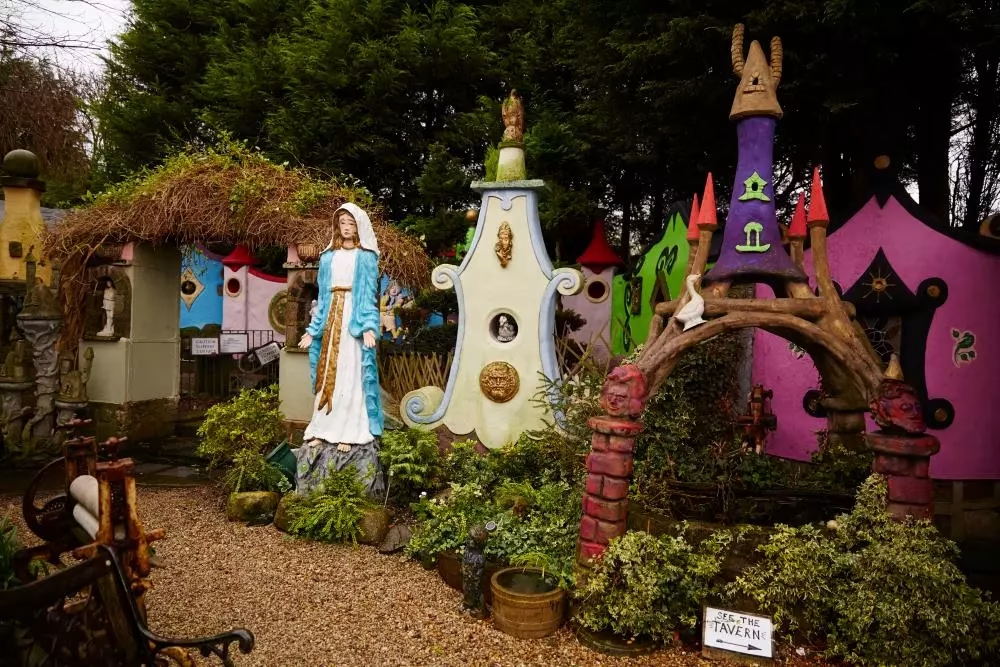Kevin Duffy’s whimsical narrative began in an abandoned lot. While others saw mere debris, he recognized the hidden promise within the overgrown remnants of a 1920s bowling green. Over the decades, he transformed his Wigan garden into a fantastical realm, crafting castles, characters, and rustic Tudor facades using chicken wire, cement, and found materials, all surrounding his bungalow and spilling into the family garden center.
Few are familiar with Duffy, who passed away in September at the age of 79, or his imaginative works that were housed at the now-closed Rectory Nurseries. However, those who encounter his creations often respond with a mix of astonishment and delight. After four decades of creativity, Duffy’s enchanting kingdom boasts twisting pathways, chapels, dens, and mythical creatures, each turn revealing a new delight. Among his artistic wonders are a miniature pub, a lion’s den, and a cave adorned with stalactites. It resembles a whimsical theme park.
Iain Jackson, an architect and writer who interviewed Duffy for the outsider art magazine Raw Vision in 2008, acknowledges that Duffy’s work may not fit within traditional gallery settings. Still, he emphasizes, “He had something to express – he was the real deal.” However, alongside his legacy as a cherished outsider artist, Duffy left behind a 1,200-square-foot property filled with his sculptures, curios, and oddities, creating a puzzling dilemma for those tasked with its future.
The land on which the Rectory sits is now facing a sale, prompting local residents to question why Duffy’s work isn’t eligible for protection. Last year, a unique flat in Birkenhead, known as Ron’s Place, became the first outsider art site to receive Grade II-listed status. In stark contrast, the Rectory remains closed off, overtaken by wild vines and trees that envelop its whimsical follies, resembling a post-apocalyptic landscape.
Described by his nephew Chris as “eccentric,” Duffy’s life was rich with diverse experiences, from performing in a musical duo to working in a cotton mill and possessing an encyclopedic knowledge of gardening. Each evening, he would gather with family, sporting his cowboy neckerchief, to entertain with music and laughter, outpacing even his most lively nephews.
His eldest sister, Sheila, recalls Duffy as a charming child who didn’t initially exhibit strong artistic inclinations beyond his appreciation for architecture. He grew into a diligent worker with calloused hands, leasing the vacant land for just £1 per year in the late 1970s. He gradually transformed it into his home, constructing it in 1991 while nurturing his nursery business.
Labeled by some as “Wigan’s Gaudi,” Duffy found his artistic voice only after the sudden passing of his wife, Pat, in 1994. He erected a stone monument in her memory, sparking a wave of creativity that lasted decades. The Rectory is imbued with symbols of his grief and remembrance, with an all-faith chapel uniquely built from old toilet bricks, becoming a heartfelt space for solace and reflection.
Duffy’s creations were never intended to be standalone works; instead, he envisioned his home and garden as a dynamic gallery meant for both personal enjoyment and public exploration. Layers of eclectic objects formed a sprawling masterpiece consisting of over a hundred interconnected sections: a hand-sculpted Mr. Darcy, a gravestone for a beloved donkey, and heartfelt tributes to his late wife and their son, Carl, who passed away in 2023.
His artistic endeavors were often driven by available materials, as Duffy famously said, “building a lot without buying a thing.” He playfully questioned whether his efforts constituted art or merely a heap of discarded items.
Sadly, Duffy’s whimsical wonderland faces an uncertain future, mirroring the ongoing struggle of outsider art preservation. Many pieces have been discarded as trash, while others have found their way to more reputable galleries, highlighting the reliance on dedicated individuals to safeguard artistic legacies.
With Duffy’s passing, a tangible sorrow envelops the Rectory. As Sheila notes, “The fact that Kevin is no longer with us is difficult, but selling his life’s work for mere commercial gain is profoundly sad.” The family, lacking ownership of the land, hopes for a buyer who will respect Duffy’s creations, though they acknowledge its unlikely all will be preserved.
Chris remains optimistic about maintaining Duffy’s legacy. “No matter what happens to the garden, our Kevin has left a unique mark on the world, and the memories will endure,” he reflects.
While some may argue against the necessity of preserving every aspect of Duffy’s imaginative landscape, it’s clear his contributions have left an indelible impression, cherished by those who experienced his extraordinary vision.













